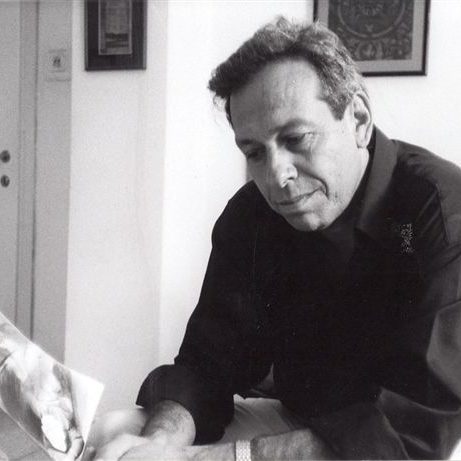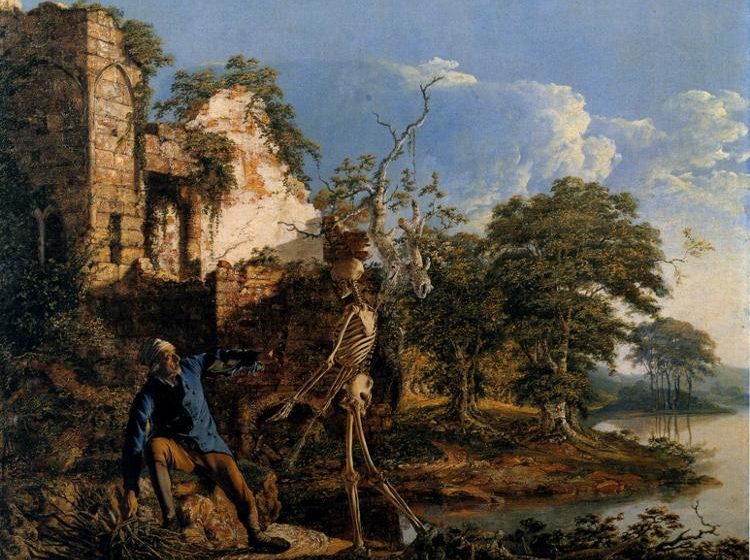The mental and spiritual meaning of encountering the world of death, to feel death while we are still alive, is associated with breakdowns and losses, both in life transitions, consciousness transitions, and creative processes. The phenomenon of death is with us in life itself wherever we turn, in the perishable nature around us, in the information of the communication, in the news of the day, and in general in culture as in art.
But the fact of our death, or those close to us, is unbearable and is not easy to digest, accept, or understand. That is how it has been and will always be. And from this difficulty comes the influence of our perception of death. Death will always remain as a frightening and threatening thing, the most terrible of all, as insolvency, decay, and other images of this kind.
We do not see that it is the fact of death that makes us human and that it also has a role in the way we perceive life as a temporary process that must be realized and should be exhausted, and this is what makes life process special as well.
If we look back, to the ancient world, to ancient religions and cultures, to myths and legends, we can see how death, the afterlife, the fear of death, and preparation for it, were intertwined with ancient myths, rituals and texts.
The fact of death and the inevitable finality of man has always aroused in him a great ambivalence on the one hand, of course, fears, horror, and a tremendous urge to deny and repress, to avoid or to prepare for the Day of Judgment, and on the other hand curiosity, attraction and tremendous imagination about what happens after that, what is the other world where is everything going? The reactions have always been extreme, from total denial, reluctance, distancing, and an attempt to see it as an impurity to constant preparation and an attempt to see death as the pinnacle of achievement and the beginning of a mysterious and magical journey. And at the same time, death is a fact that can also stimulate the person to cling healthier to life and exhaustion.
The death plot, the concrete place that symbolizes death, the cemetery, the catacombs, the large firms, and tombstones also show the enormous attitude that man has to die and what will happen after it. There is tremendous power to the crypt, to the ascent to the graves, there is awe, and there are beliefs of prostration of the person on graves to get something emotional from there like wisdom, advice, blessing, magic, and even miracles.
.The burial place of the important person who is elevated from the people can perhaps connect the mortal man to an eternal, unknown, infinite, and archetypal world
In ancient cultures such as Egypt, there was a tremendous attraction and an unbelievable emphasis on the other world, the world of the night, the darkness where the sun sets, and the West that symbolized the world of death for them. For the Egyptians, this world was no less important and
even more important than this enlightened, living, and temporary world. To the other world, the world of death descends the king, who is also a god with the help of a special ship and with him a complete dignity and an impressive escort of gods who help him return the next day at sunrise. Throughout his life, a man prepares for this main world, where his body and soul will be reunited in a reunion of supreme significance. This union after death can serve as a symbolic metaphor for what happens at the end of the depression.
The Greeks, in the footsteps of the Egyptians, also gave the kingdom of the dead a very significant place in their worldview. The myrtle of the invisible kingdom has received a considerable representation although always ambivalent in myths in their legends and rituals. Among the three kingdoms, the Kingdom of the World, the Kingdom of the Sea, and the Kingdom of the World below, the latter was the least attractive of the three.
This kingdom has a venerable god with a hat – like an invisible hill – his name is Hades (the invisible) and a goddess – Persephone (the destroyer), as a kind of king and queen of the underworld.
A whole world in which there are borders and gates is a large dog Cerberus (the demon of the pit), with three heads that guard that there is no going out and no coming.
And of course, what happens in this mysterious world is miraculous things. A sizzling world of souls and spirits waiting for new people to arrive. They are hungry, take and give, but they possess all the world's wisdom. Greek mythology is full of accurate descriptions of the
different regions of Hades; the souls who live in a two-dimensional world have beings, the wisdom and wisdom they have acquired in their lives, they are even thirsty and hungry, and the character of the living world remains. There is joy and sadness in the world of meta-regions, and there are very clear ways of where and what is needed for a person, for a hero, before entering such a strange country.
Suppose we use psychological projection and try to see everything attributed to this unknown world as a projection of humans on the unknown, infinite, and eternity. In that case, we can try to understand how their psyche worked and what filled their unconscious. What imaginations were running around among the intellectuals and clerics in ancient times, how they thought about the end, what they feared, and how they took advantage of it to influence people in general. We can also understand what the people aspired to and their desires, both in the matter of ending and regarding everything that was a contrast to a bright and clear life.
We always understand that the imagined land of the dead is, of course, also associated with the incompleteness with the fact of death, which is the inevitable end, but also with pain, suffering, depression, a deep crisis within life, and with a mental and emotional detachment of any kind from life itself.
The contents of the place, the souls and wisdom in the world of down, show us that this land expresses the eternity of things, infinity. Such a view assumes that despite the death of the body of each person, nothing that man has achieved is lost in the world, but rather he simply finds another form of existence in the world of death, the world of the soul. It is a world of spirit, a world of continuity, but also a world of endless punishments and rewards for the souls of the dead who succeeded or sniffed in their lives.
That is why it is a world with a kind of good power or terrible punishment, that of the essence of human wisdom and everything that human beings have accumulated since time immemorial. Therefore, this world is attractive and aversive, and staying in it could be a shock but can give strength, wisdom, recall, creativity, and transformation. What experiences the person needs in his life and the transitions, especially when caught up in crises, going through gatherings, and internal journeys. The person who mentally enters the kingdom of death and manages to get out of it reaches deep insights and leaves with his reward in his hand.
In these ways, this world of death also represents for us parts of the unconscious layer of the psyche, the super personal unconscious, the archetypal world as C.G. Jung calls it, a world that has always existed and is the human infrastructure of all human beings accumulated in all its layers.
That is, the same world that represents the end, the world we reach after death, the place from which we can look at our lives with the help of imagination, from a supposedly high view, from where those who are no longer are located, is in fact an important component of the unconscious. Is it the beginning, and is it also the end? Hades' stories tell that a soul that goes out and ascends to enter a new body must first be baptized in the river Stitches to forget everything in Hades and reach a pure and clean world.
.
We learn that the world of death is related to the base of the psyche, the earliest layer into which one falls when there is a crisis, into which one enters, into which one descends or is thrown, one is caught peeking and getting hurt when our enlightened realistic and rational, sane life is cracked. And some gifted people can go down to it to sustain creative processes.
The fracture, the breakdown and the fall bring the person to myrtle into the world of souls to the place of the beginning and the end.
We will see briefly, who are all in mythology who are passing through or are in this unknown and mysterious world.
First are the goddesses of destiny, Moirés, the three goddesses weaving the strings: one forms the thread, one measures its length, and the third cuts. Secondly, there are Erinyes, Furies, the goddesses of basic, instinctive conscience who can punish and pursue with severe guilt those who break the laws of human nature. Natural laws about parents and children, penalties for incest, and abuse of a family member.
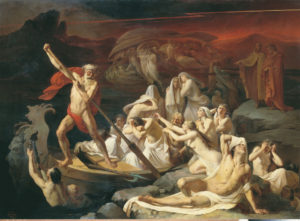
Michelangelo's Charon
Also, there are the night god and the dream. And Somonis Hypnos, the sons of Night, whose employee invented them there, shows us how much the Greeks thought that the state of sleep was associated with death and the dream, with the so-called possibility of visiting the spirit world of the underworld. Also, down there is the dark witch with superpowers –
Hekate (the owner of the Hundred). –The Hidden Witch Mother, who represents various dark forces, as in Judaism, is the image of Lilith. And of course, there are all the souls of the important personas in mythology whose spirits represent archetypical powers of heroes, sages, warriors, and especially the ancient prophets.
But there are also examples of privileged personas who received eternal punishment for betraying the gods. These express extreme mental states that symbolize the detachment from life and the entry into a vicious, circle of action like ritual compulsion punishable for a fatal mistake they made in life precisely after receiving gifts from the gods.
 Tantalus _colorful _modern
Tantalus _colorful _modern
The characters of the anguished Tantalus could not enjoy all the good he had and received from the gods; he received punishment for cheating the gods, taking advantage of their kindness, and hurting his son for further honor. There is Sisyphus (the clever one) who took advantage of the ingenious supervision he received from the gods to outwit even the head of the gods Zeus, and as a punishment for such a Hybris, he must roll the stone forever. There is Ixion (the native) who received phenomenal sexual ability; he was not satisfied with the daughters of humans and tried to seduce Hera with dignity and herself; his compulsive eternal punishment was to walk around forever in the trap of a fire wheel. And, of course, danaids who were daughters of Danae's (the judge, by the way, with closeness to the sons of Dan the Hebrews). they were extremely wise women, but under the influence of their father's vengeance on his nephews and lack of self-judgment, their husbands piled up cousins and murdered them. Their punishment was to move water in a perforated strainer forever from place to place. An action that was attributed to the beginning of the development of artificial irrigation in agriculture was the funnel.
Anyone who enters the secret of Hades, and manages to get out of there, undergoes a mental transformation, a tremendous upheaval but also a very important change. This theme manifests itself in personal life, especially when we are dealing with the experience of the mental death of a person within his life, his mental life, and his work.
? And what is the significance of entering Hades while you are still alive
And that's our thing! If we look at life as a sequence of passing through intersections, partings of losses and transitions, until facing death itself, we will see that the Hades experience appears in each person throughout his life several times and not necessarily through the direct facing of his own death at the end of his life.
There is no doubt that for a person who loses his loved ones already in childhood, a crisis will be created in him, a void in his soul and his connection to everything that symbolizes death Hades will become tighter than for another person whose childhood is not associated with the experience of death. It is not like a child to be associated with the world of the dead; but on the contrary, the beginning of his life is symbolized by life. Therefore, the child is naturally protected by his parents and environment. Even if he is touched, he is usually built with strong defenses of the self, such as denial, repression, and illusion of a child.
This world of the dead of encountering spirits sometimes arises already with the crisis of adolescence. The crisis of checking boundaries, encountering limitations, and declining from omnipotence – omnipotence – as like the descent into the other world. And the crisis of parting, of leaving home, can sometimes be experienced as a fall to Hades as a kidnapping into Hades as an occurrence that must be lost as a death experience. Like Persephone.
Throughout life, several nodes can have the character of a severe crisis and a descent down to Hades. like an encounter with a kind of death, an upheaval after which the person must work through emotionally what he is experiencing. And then his life will become others from that moment, or he with himself and his soul will be another person from before the crisis.
We can gain if we want to attach to these crises throughout life, a suitable myth that tells us about this kind of experience that is mythological and therefore archetypical, gain a general pattern in which each personal life of an individual has cast a different unique story.
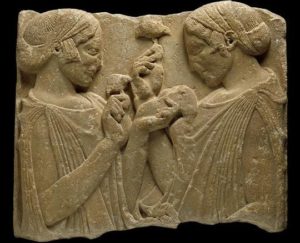
Demeter- Ceres and Persephone
Already in the heartbreaking separation of the daughter from the mother figure, while moving to a partner, to a new family bond that will replace the strong bond in the original family, we can meet a crisis. A crisis that, with all the joy of the wedding, brings a touch on one level or another with the experience of the land of the dead that appears in the myth of Persephone's kidnapping from her mother Demeter. It is a natural crisis for the circle of life but can be an extreme crisis in situations of unresolved ties in the family of origin.
Alternatively, we will see a problem of compulsive avoidance of such a crisis, avoiding separation from the mother, which will lead to severe difficulty in establishing meaningful connections outside the family of origin or sometimes a crisis and escape back to the family of origin. Persephone's house of Demeter is kidnapped by the god of Hades, who wants her for a wife and is afraid of the goddess Mother Demeter. Mythology emphasizes the mother's harsh reaction to the abduction of her daughter, the difficult situations she goes through, rage and depression and the shaking of the world, and then the resulting compromise of the kidnapping and separation, in a life divided down with the husband and up with the mother, according to the rhythm of the seasons. A compromise that every mother and daughter must go through together.
adolescent
Even in the adolescence of the boy or girl, the adolescent in the adolescent sometimes a general crisis breaks boundaries, a crisis that can lead to a difficult encounter with the limits, boundaries of life and even encountering death, sanity and madness, the self and the outside, the outside and the interior. And the crisis sometimes leads to examining the limits of life and death and an encounter with death to strengthen life and the boundaries. Among the works of the Hero Hercules, among the punishments he received to strengthen himself and his self-control, he must go down to Hades and bring the dog Cerberus of the Hades borders to take it over and take it out, bring it alive and bring it back afterward. Hercules' descent into myrtle to know the limits and strengthen them is very important at the time of building and strengthening the adolescent self. Do not be
afraid; go down, recognize limits and limitations and overcome the fears of death and the fears of life. And really about Hercules, who can symbolize such a teenager overcoming both worlds.
The descent into Hades in the work of marriage and the joint couple circle
There, too, in the relationship and its development, we will see crises characterized by the need to touch the other world as symbolized by the world of death, of the spirit, so as not to be fixed only in the material world in the world of physical desire alone.
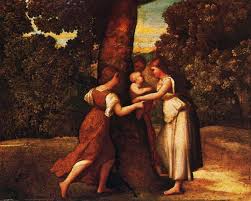
Psyche In Hades
Also, in marriage, as in any relationship process, one must develop the ability to raise love to a high place of meaning; one must learn, besides physical erotic love, to love emotionally and spiritually. The erotic infatuation built a lot on physical beauty and passion does not last long if it does not merge with the love of the partner, the love of the person in him, the friendship, and the vision of beauty and essence.
The simple passion may pass and can easily lead to crises and a sense of loss that is like death. The myth that fits to describe it deals with the journey of Psyche (the human soul) yearning to regain her beloved Eros, an Amor who was lost to her after looking at him. To do this, she Psyche must also go down to ask. She descends to bring away the beauty box of Persephone, the goddess of the underworld, a beauty that symbolizes something beyond the beauty of the goddess Venus Aphrodite- the goddess of passion, love, and connection. Here in this development with the descent, it must meet the realm of the spirits, the deep and hidden world to which one descends in pain, to undergo a change and know how to love through emotion and meaning. Her love for her beloved Amor takes on another dimension of the higher self. But to reach this dimension, it must go through a crisis, so to speak, to die. She is forced to give up the physical beauty of my passion and learn to love from a different and new place to her.
Also, the mid-life crisis, the crisis of the need to give up the ego, the instincts, to give up the power, the Persona, and to shift the weight from the Ego to the self- ego axis to me. a Shift that holds the potential of death. An encounter with losses, concessions, surrender of the ego to something more fundamental in the psyche and personality development. It is necessary to kill something, bury it, and mourn through soul-searching and deep observation. Mourning for what was not and will not be, but for what you will not be and understanding the separateness and exit from couple symbiosis. This decline is accompanied by a crisis and brings a person closer to a feeling of death at the end of life.
Odysseus' search for the way home and the advice he receives from the witch Circe is very relevant to this crisis. Odysseus, the adventure-learning hero, the trickster who must go down to Hades to meet the spirit of the Prophet Theresia, to understand the world of death, the death of his mother, to know the existence of the other, to come down from his Hybris, will be able to symbolize for us the self that develops after a mid-life crisis.
To go down in and after a crisis to get more tools for managing the rest of life. To meet the archetype of the wise old man in the form of the Prophet, to meet other characters from our lives to know the Other and take greater responsibility for our past and future behavior. To Get to know also the world of spirit and feelings. To know that there in this realm the laws are different. Odysseus comes out intoxicated, he manages to live in both worlds. And he is equipped now to come home.
Of course, there are also many unforeseen crises of loss and disease that force the person to face death that comes from the decrease in the strength of the body or the decay of the body. Such a confrontation with a serious illness can bring the person to a crisis on the one hand but also to the development of his psyche, the development of meaning, and the rapprochement of the self. In this case, the dream world can be beneficial to work with the healing properties of the unconscious.
Another encounter associated with the world of spirits and death is the encounter with the world of the dead in the creative processes, following crises, suicidality, or leaving the Hades connection through the artist's wound – the decline of Orpheus after the loss of his beloved Euridice. The loss of creativity and the search for the archetypal layer is deep in the world of death.
.
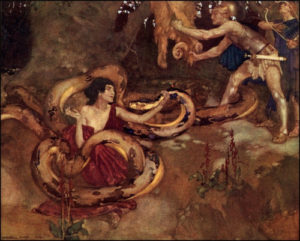 .
.
